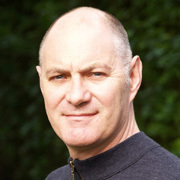
Cameron Chittock
Although he was born in Dunedin, Cameron Chittock grew up Christchurch. His childhood was "very sports-driven" — including a stint playing representative rugby for Canterbury. "But art was always there. When I wasn't running or playing rugby, I was in my room drawing. I was always into characters and wierd creatures."
Later, at Christchurch Polytechnic —where his visual communications course involved everything from graphic design to puppet making — Chittock heard about a low budget film being shot by an unknown director named Peter Jackson.
The film would be called Bad Taste, and Chittock signed on to help out on some of the more ambitious special effects, including alien heads and a house which transforms into a spaceship. He was impressed by Jackson's ability to know just how much work was required to make a particular illusion work on-screen.
During the making of Bad Taste, Chittock and Jackson came up with the idea of a film featuring dodgy puppets — "the idea of very basic, very cartoon character doing things that if you got real actors to do, you would never get away with it". Chittock initially designed 24 puppets, which helped fuel a script. The plan was for the puppet project to be part of a proposed TV series, and Chittock was among those who invested money into filming a pilot. Although it was never completed, some of the footage won interest from Japanese investors, and the project was ultimately reborn as Jackson's second feature Meet the Feebles.
Chittock remembers Feebles as both "really tough", and "a major break" in his career. He designed and oversaw the creation of 96 characters — from a drug-addicted rabbit, to a two metre high hippo suit — and made over half of them himself (future Wētã Workshop co-founders Richard Taylor and Tania Rodger were also part of the creature crew). The film's ambitions outran its budget, and Jackson did a final, secret week of filming, after they'd run out of time. Chittock talks about Feebles in this documentary; His work won a 1990 NZ Film Award for Contribution to Design, and praise from Listener reviewer Chris Hegan for the "amazing" puppets, and the lively way Jackson captured them on-screen.
Chittock had been set to work on Jackson's long-delayed zombie movie Braindead, and at one point Jackson proposed that the two of them set up a special effects company together. Chittock advised that he stick to directing. Chittock was now in demand. Directly after Feebles, he headed to Auckland, to become design manager at new television channel TV3. There he produced a series of short animated films, and created puppets for Suzy Cato's Early Bird Show and You and Me. After leaving TV3 in the mid 90s, Chittock pitched the idea of TV series Oscar and Friends to NZ On Air and TV3. The part-claymation series centred on the adventures of a boy and two imaginary friends.
"I wanted to make my own TV show instead of working on other people's stuff. Plus there weren't many kids TV shows being made in New Zealand at the time, and none of it was travelling overseas." Chittock flew to England and persuaded some of the Aardman Animation team to head downunder, and help him set up and train the team. Kiwi animator Euan Frizzell was also key — "working with Euan was an incredible experience; his knowledge and wisdom really helped". The 26 five-minute long episodes sold to 160 countries.
Oscar and Friends was distributed by Australian company Southern Star Entertainment. A producer at the company later asked Chittock if he had any ideas for kids shows which "might inspire kids to be creative". Chittock pitched The Adventures of Bottle Top Bill and his Best Friend Corky, which featured characters and settings 'made' from everyday objects. Southern Star were keen, though they were less enthused about the likely costs of bringing the show to life via stop motion animation. "I came up with the idea of taking photos of my stop frame models and animating them using a complex 2D process . . . Southern Star liked the look, and suddenly it was all on."
Although there were hopes of making it in New Zealand, the show was ultimately produced in Singapore and Australia. The first series cost Australian $6.9 million. Over four years and three seasons in Singapore, Chittock spent long days teaching the crew, and worked on the show at night. Bottle Top Bill sold to 180 territories. It rated especially highly on ABC in Australia and Channel Five in the United Kingdom.
Chittock then headed to Australia to join the directing team on odd couple insect series Erky and Perky. By 2009 he was back in New Zealand. Earlier he had worked on short film Life on Ben with Luke Nola, which Nola turned into a TV series.
Chittock continues to direct animated shows — including Flux Animation's Wiki the Kiwi and coproduction Sindbad and the 7 Galaxies — but he has moved increasingly into producing and management roles. Chittock did time as Head of Production at both Huhu Studios (where he was part of the team on animated movie Mosley) and Pūkeko Pictures (after doing time as a director and producer).
Chittock went on to become one of the trio who run Auckland visual effects company PRPVFX. In 2025 he was visual effects producer on Amazon sci-fi hit Ash. PRPVFX handled the effects for 340 shots.
Profile written by Ian Pryor; updated on 24 June 2025
Sources include
Cameron Chittock
Chris Hegan, 'Gross-out genius' (Review of Meet the Feebles) - The Listener, 15 October 1990, page 107
Ian Pryor, Peter Jackson - From Prince of Splatter to Lord of the Rings (Auckland: Random House New Zealand, 2003)
Unknown writer, 'About the Adventures of Bottle Top Bill and His Best Friend Corky' TVNZ website. Accessed 13 March 2017
Meet the Feebles press kit